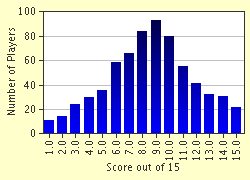Quiz Answer Key and Fun Facts
1. PALEOZOIC: When did this era begin?
2. Cambrian (540-500 million years ago): Which of these theories are given about this period?
3. Ordovician (500-440 million years ago): Which well known group of animals thrived during this period?
4. Silurian (440-410 million years ago): Which mountain range rose in the orogeny with the same name, which took place during this period?
5. Devonian (410-360 million years ago): Many different fish groups from the "Age of fishes", as this period is called, have survived to this day. However, which of these became extinct even before this period was over?
6. Carboniferous (360-280 million years ago): What is the name of this period referring to?
7. Permian (280-250 million years ago): What percent of the ocean life was wiped out at the end of this period?
8. MESOZOIC: What is the popular name for this era?
9. Triassic (250-210 million years ago): What was the name of the supercontinent that tied all the land together?
10. Jurassic (210-145 million years ago): Which group of dinosaurs from this period included the largest animals ever to walk the face of the Earth?
11. Cretaceous (145-65): Where did the giant asteroid, which is supposed to have led to the mass extinction at the end of this period, fall?
12. CENOZOIC: Which of these 'break-ups' occur during this era?
13. Paleogene (65-24 million years ago): Which of these is NOT a subdivision for this epoch?
14. Neogene (24-1.8 million years ago): What was the representative factor that determined major environmental and climatic changes in the last part of this period?
15. Quaternary (1.8-?): Which of these was a "cat" menace for the early humans?
Source: Author
Mr5
This quiz was reviewed by FunTrivia editor
crisw before going online.
Any errors found in FunTrivia content are routinely corrected through our feedback system.


